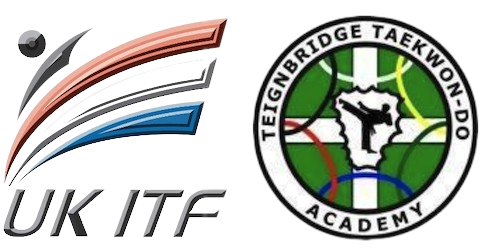ITF 2nd Kup Red Belt
Grading Syllabus
Theory
1. What is the meaning of pattern Hwa-rang? – Hwa-rang is named after the Hwa-rang youth group which originated in the Silla dynasty about 600 A.D. This group eventually became the driving force for the unification of the 3 Kingdoms of Korea. The 29 movements refer to the 29th Infantry division, where Taekwon-Do developed into maturity.
2. Who was the head of the 29th Infantry division? – General Choi Hung Hi.
3. What is Hwa-rang translated into English? – Flowering youth.
4. How do you form closed ready stance ‘C’ (demonstrate) and what is it in Korean? – Moa junbi sogi ‘C’
5. What is palm pushing block in Korean? – Sonbadak miro makgi
6. What is vertical stance in Korean? And explain it – Soojik sogi
7. What is downward knife hand in Korean? – Naeryo sonkal taerigi
8. How many patterns have release moves? There are three, Do-San, Joong-gun and Hwa-rang demo and explain the difference.
9. What is the meaning of Black belt? – Black is the opposite to white, therefore signifying maturity and proficiency in Taekwon-Do. It also indicates the wearer’s imperviousness to darkness and fear.
10. Name 7 different kicks in English and Korean – Front snap kick (Apchabusigi) Turning kick (Dollyo chagi) Side piercing kick (Yop chajurugi) Back kick (Dwit chajurugi) Downward kick (Naeryo chagi) Back piercing kick (Bandae dollyo chagi) Pressing kick (Noolyo chagi) Consecutive kick (Yonsok chagi)
11. Name 8 different blocks in English and Korean – Outer forearm block (Bakat Palmok makgi) Inner forearm block (An Palmok makgi) Knife hand block (Sonkal makgi) Rising block (Chookyo makgi) Guarding block (Palmok Daebi makgi) Knife hand guarding block (Sonkal daebi makgi) Twin forearm block (Sang palmok makgi) Wedging block (Hechyo makgi) Circular block (Dollymio makgi) Hooking block (Golcho makgi) Twin knifehand block (Sonkal sang makgi) Double forearm block (Doo palmok makgi) ‘U’ shaped block (Diguta makgi) ‘W’ shaped block (San makgi) Reverse knifehand block (Sonkal dung makgi) X fist block (Kyocha joomok makgi) Double forearm pushing block (Doo palmok miro makgi)
12. Name 8 different hand parts in English and Korean – Fore fist (Ap joomuk) Back fist (Dung joomuk) Side fist (Yop joomuk) Knife hand (Sonkal) Reverse Knife hand (Sonkal dung) Findertips (Sonkut) Arc hand (Bandalson) Elbow (Palkup) Palm (Sonbadak) Open fist/palm heal (Pyun joomok)
13. Name 5 different foot parts in English and Korean – Ball of the foot (Ap kumchi) Footsword (Balkal) Instep (Baldung) Heel (Dwit chook) Toes (Balkut) Instep (Baldung) Reverse footsword (Balkal dung) Knee (Moorup)
14. What is upward punch in Korean? – Ollyo Jirugi
15. What is twisting kick in Korean and what part of the foot is used? – Bituro Chagi – Ball of the foot (Ap Kumpchi)
16. Name 4 parts of your forearm in English and Korean? – Inner forearm (Bakat) Outer forarm (An) Back (Dung) Forearm belly (Mit Palmok)
Korean Terms
| English | Korean |
| Palm Pushing Block | Sonbadak Miro Makgi |
| English | Korean |
| Downward Knifehand Strike | Naeryo Sonkal Taerigi |
| Upward Punch | Ollyo Jirugi |
| Downward (Axe) Kick | Naeryo Chagi |
| Twisting Kick | Bituro Chagi |
| English | Korean |
| Vertical Stance | Soojik Sogi |
| Closed Ready Stance C | Moa Chumbi Sogi C |
| English | Korean |
| Reverse Footsword | Baldung Dung |
